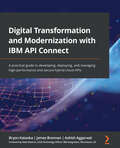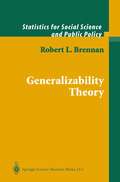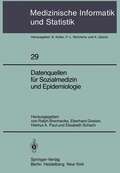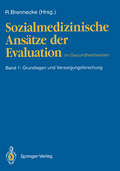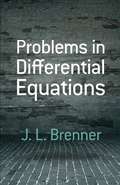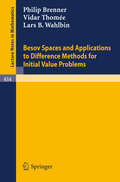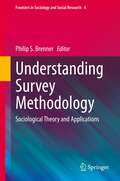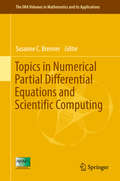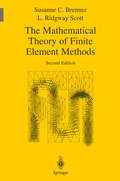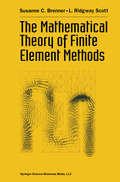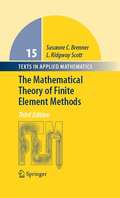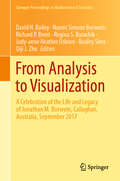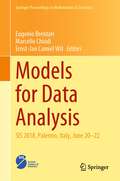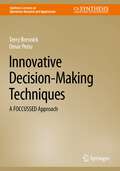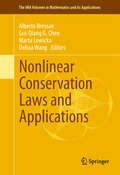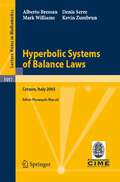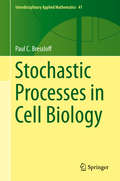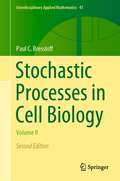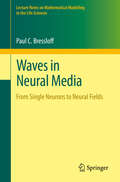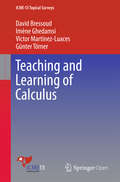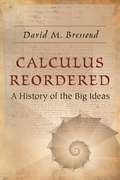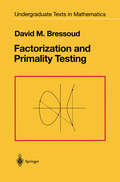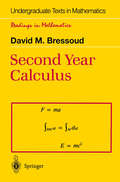- Table View
- List View
Digital Transformation And Modernization With Ibm Api Connect: A Practical Guide To Developing, Deploying, And Managing High-performance And Secure Hybrid-cloud Apis
by James Brennan Bryon Kataoka Ashish AggarwalA practical guide to developing, deploying, and managing high-performance and secure hybrid-cloud APIs
Generalizability Theory (Statistics for Social and Behavioral Sciences)
by Robert L. BrennanGeneralizability theory offers an extensive conceptual framework and a powerful set of statistical procedures for characterizing and quantifying the fallibility of measurements. Robert Brennan, the author, has written the most comprehensive and up-to-date treatment of generalizability theory. The book provides a synthesis of those parts of the statistical literature that are directly applicable to generalizability theory. The principal intended audience is measurement practitioners and graduate students in the behavioral and social sciences, although a few examples and references are provided from other fields. Readers will benefit from some familiarity with classical test theory and analysis of variance, but the treatment of most topics does not presume specific background.
Aging with HIV in Sub-Saharan Africa: Health and Psychosocial Perspectives
by Mark Brennan-Ing Kristen E. Porter Jennifer E. Kaufman Catherine MacPhail Janet SeeleyWith the development of effective antiretroviral therapies (ART) in the mid-1990s, HIV became a treatable although serious condition, and people who are adherent to HIV medications can attain normal or near-normal life expectancies. Because of the success of ART, people 50 and older now make up a majority of people with HIV in high-income countries and other places where ART is accessible. The aging of the HIV epidemic is a global trend that is also being observed in low- and middle-income countries, including countries in sub-Saharan Africa, where the greatest number of older people with HIV reside (3.7 million). While globally over half of older adults with HIV are in sub-Saharan Africa, we have little information about the circumstances, needs, and resiliencies of this population, which limits our ability to craft effective policy and programmatic responses to aging with HIV in this region. At present, our understanding of HIV and aging is dominated by information from the U.S. and Western Europe, where the epidemiology of HIV and the infrastructure to provide social care are markedly different than in sub-Saharan Africa. Aging with HIV in Sub-Saharan Africa addresses this gap in our knowledge by providing current research and perspectives on a range of health and psychosocial topics concerning these older adults from across this region. This volume provides a unique and timely overview of growing older with HIV in a sub-Saharan African context, covering such topics as epidemiology, health and functioning, and social support, as well as policy and program implications to support those growing older with HIV. There are very few published volumes that address HIV and aging, and this is the first book to consider HIV and aging in sub-Saharan Africa. Most publications in this area focus on HIV and aging in Uganda and South Africa. This volume broadens the scope with contributions from authors working in West Africa, Botswana, and Kenya. The range of topics covered here will be useful to professionals in a range of disciplines including psychology, epidemiology, gerontology, sociology, health care, public health, and social work.
Datenquellen für Sozialmedizin und Epidemiologie (Medizinische Informatik, Biometrie und Epidemiologie #29)
by R. Brennecke E. Greiser H. A. Paul E. SchachSozialmedizinische Ansätze der Evaluation im Gesundheitswesen: Band 1: Grundlagen und Versorgungsforschung
by Ralph BrenneckeProblems in Differential Equations (Dover Books on Mathematics)
by J. L. BrennerA supplement for elementary and intermediate courses in differential equations, this text features more than 900 problems and answers. Suitable for undergraduate students of mathematics, engineering, and physics, this volume also represents a helpful tool for professionals wishing to brush up on their problem-solving skills.The book is divided into twenty sections, each preceded by a clear and logical explanation of the basic ideas needed for solving the problems within the section. Many fully explained illustrative problems appear throughout the text. Subjects include applied routine and nonroutine problems in vibrations, electrical engineering, mechanics, and physics. Stars indicate advanced problems. Short mathematical and numerical tables are provided at the end of the book.
Besov Spaces and Applications to Difference Methods for Initial Value Problems (Lecture Notes in Mathematics #434)
by P. Brenner V. Thomee L.B. Wahlbina
Understanding Survey Methodology: Sociological Theory and Applications (Frontiers in Sociology and Social Research #4)
by Philip S. BrennerThis volume ambitiously applies sociological theory to create an understanding of aspects of survey methodology. It focuses on the interplay between sociology and survey methodology: what sociological theory and approaches can offer to survey research and vice versa. The volume starts with a focus on direct connections between sociological theories and their applications in survey research. It further presents cutting-edge, original research that applies the “sociological imagination” to substantive concerns important to sociologists, survey methodologists, and social scientists and includes issues such as health, immigration, race/ethnicity, gender and sexuality, and criminal justice.
Topics in Numerical Partial Differential Equations and Scientific Computing (The IMA Volumes in Mathematics and its Applications #160)
by Susanne C. BrennerNumerical partial differential equations (PDEs) are an important part of numerical simulation, the third component of the modern methodology for science and engineering, besides the traditional theory and experiment. This volume contains papers that originated with the collaborative research of the teams that participated in the IMA Workshop for Women in Applied Mathematics: Numerical Partial Differential Equations and Scientific Computing in August 2014.
The Mathematical Theory of Finite Element Methods (Texts in Applied Mathematics #15)
by Susanne Brenner L. Ridgway ScottA rigorous and thorough mathematical introduction to the subject; A clear and concise treatment of modern fast solution techniques such as multigrid and domain decomposition algorithms; Second edition contains two new chapters, as well as many new exercises; Previous edition sold over 3000 copies worldwide
The Mathematical Theory of Finite Element Methods (Texts in Applied Mathematics #15)
by Susanne Brenner L.Ridgway ScottMathematics is playing an ever more important role in the physical and biological sciences, provoking a blurring of boundaries between scientific disciplines and a resurgence of interest in the modern as well as the clas sical techniques of applied mathematics. This renewal of interest, both in research and teaching, has led to the establishment of the series: Texts in Applied Mathematics (TAM). The development of new courses is a natural consequence of a high level of excitement on the research frontier as newer techniques, such as numerical and symbolic computer systems, dynamical systems, and chaos, mix with and reinforce the traditional methods of applied mathematics. Thus, the purpose of this textbook series is to meet the current and future needs of these advances and encourage the teaching of new courses. TAM will publish textbooks suitable for use in advanced undergraduate and beginning graduate courses, and will complement the Applied Math (AMS) series, which will focus on advanced textbooks ematical Sciences and research level monographs. Preface This book develops the basic mathematical theory of the finite element method, the most widely used technique for engineering design and analysis. One purpose of this book is to formalize basic tools that are commonly used by researchers in the field but never published. It is intended primarily for mathematics graduate students and mathematically sophisticated engineers and scientists. The book has been the basis for graduate-level courses at The Uni versity of Michigan, Penn State University and the University of Houston.
The Mathematical Theory of Finite Element Methods (Texts in Applied Mathematics)
by Susanne Brenner Ridgway ScottThis is the third and yet further updated edition of a highly regarded mathematical text. Brenner develops the basic mathematical theory of the finite element method, the most widely used technique for engineering design and analysis. Her volume formalizes basic tools that are commonly used by researchers in the field but not previously published. The book is ideal for mathematicians as well as engineers and physical scientists. It can be used for a course that provides an introduction to basic functional analysis, approximation theory, and numerical analysis, while building upon and applying basic techniques of real variable theory. This new edition is substantially updated with additional exercises throughout and new chapters on Additive Schwarz Preconditioners and Adaptive Meshes.
From Analysis to Visualization: A Celebration of the Life and Legacy of Jonathan M. Borwein, Callaghan, Australia, September 2017 (Springer Proceedings in Mathematics & Statistics #313)
by Richard P. Brent David H. Bailey Regina S. Burachik Naomi Simone Borwein Judy-anne Heather Osborn Brailey Sims Qiji J. ZhuStudents and researchers from all fields of mathematics are invited to read and treasure this special Proceedings. A conference was held 25 –29 September 2017 at Noah’s On the Beach, Newcastle, Australia, to commemorate the life and work of Jonathan M. Borwein, a mathematician extraordinaire whose untimely passing in August 2016 was a sorry loss to mathematics and to so many members of its community, a loss that continues to be keenly felt. A polymath, Jonathan Borwein ranks among the most wide ranging and influential mathematicians of the last 50 years, making significant contributions to an exceptional diversity of areas and substantially expanding the use of the computer as a tool of the research mathematician. The contributions in this commemorative volume probe Dr. Borwein's ongoing legacy in areas where he did some of his most outstanding work: Applied Analysis, Optimization and Convex Functions; Mathematics Education; Financial Mathematics; plus Number Theory, Special Functions and Pi, all tinged by the double prisms of Experimental Mathematics and Visualization, methodologies he championed.
Models for Data Analysis: Sis 2018, Palermo, Italy, June 20-22 (Springer Proceedings In Mathematics And Statistics Ser. #402)
by Eugenio Brentari Marcello Chiodi Ernst-Jan Camiel WitInnovative Decision-Making Techniques: A FOCCUSSED Approach (Synthesis Lectures on Operations Research and Applications)
by Terry Bresnick Omar PeriuThis book provides a blend of quantitative and qualitative approaches to decision making, while also bridging the gap between the theory of how to make good decisions versus how people actually make decisions. The authors present the tools and techniques of decision analysis to learn how to become a FOCCUSSED decision maker: Identify and properly Frame the decision or problem at handSpecify the goals, Objectives, and values that you are trying to achieveDevelop creative, meaningful Choices from among which you can chooseEvaluate the Consequences of selecting each alternative using your goals, objectives, and valuesThink about the key Uncertainties that could impact the decisionUnderstand the Swaps and trade-offs that you are willing to makeDevelop an approach for implementing your SolutionElicit the data you’ll need from a variety of sourcesand Disseminate and communicate your decisions to others. The authors define a decision as the choice among alternatives, based on how we value and trade-off their pros and cons, made in the face of uncertainty about what will actually happen. The decision-making process is presented as having three pillars to support the decision maker: Preferences–what we prefer, what meets our goals and objectives, and the recognition that preferences are personal to the one making the decision; Alternatives–the choices, options, or courses of action that we have, and over which we have some degree of control; and Information–what we know about the situation, what we don’t know, how we connect choices to outcomes, and how we deal with uncertainty. Key components of good decision-making include how to define your goals and objectives, how to incorporate uncertainties that we all face, and how to develop better alternatives, all of which are discussed. Sophisticated techniques are presented in a way that is accessible to the average decision maker. Probability theory is utilized to improve decisions, and uncertainties are captured in decision trees. Risk avoidance, risk transfer, and risk mitigation are also discussed. Readers will gain a clear understanding of how to articulate the goals and objectives that should be the focal point of any decision.
Nonlinear Conservation Laws and Applications (The IMA Volumes in Mathematics and its Applications #153)
by Alberto Bressan Marta Lewicka Dehua Wang Gui-Qiang G. ChenThis volume contains the proceedings of the Summer Program on Nonlinear Conservation Laws and Applications held at the IMA on July 13--31, 2009. Hyperbolic conservation laws is a classical subject, which has experienced vigorous growth in recent years. The present collection provides a timely survey of the state of the art in this exciting field, and a comprehensive outlook on open problems. Contributions of more theoretical nature cover the following topics: global existence and uniqueness theory of one-dimensional systems, multidimensional conservation laws in several space variables and approximations of their solutions, mathematical analysis of fluid motion, stability and dynamics of viscous shock waves, singular limits for viscous systems, basic principles in the modeling of turbulent mixing, transonic flows past an obstacle and a fluid dynamic approach for isometric embedding in geometry, models of nonlinear elasticity, the Monge problem, and transport equations with rough coefficients. In addition, there are a number of papers devoted to applications. These include: models of blood flow, self-gravitating compressible fluids, granular flow, charge transport in fluids, and the modeling and control of traffic flow on networks.
Hyperbolic Systems of Balance Laws: Lectures given at the C.I.M.E. Summer School held in Cetraro, Italy, July 14-21, 2003 (Lecture Notes in Mathematics #1911)
by Alberto Bressan Denis Serre Mark Williams Kevin ZumbrunThis volume includes four lecture courses by Bressan, Serre, Zumbrun and Williams and a Tutorial by Bressan on the Center Manifold Theorem. Bressan introduces the vanishing viscosity approach and clearly explains the building blocks of the theory. Serre focuses on existence and stability for discrete shock profiles. The lectures by Williams and Zumbrun deal with the stability of multidimensional fronts.
Stochastic Processes in Cell Biology (Interdisciplinary Applied Mathematics #41)
by Paul C. BressloffThis book develops the theory of continuous and discrete stochastic processes within the context of cell biology. A wide range of biological topics are covered including normal and anomalous diffusion in complex cellular environments, stochastic ion channels and excitable systems, stochastic calcium signaling, molecular motors, intracellular transport, signal transduction, bacterial chemotaxis, robustness in gene networks, genetic switches and oscillators, cell polarization, polymerization, cellular length control, and branching processes. The book also provides a pedagogical introduction to the theory of stochastic process – Fokker Planck equations, stochastic differential equations, master equations and jump Markov processes, diffusion approximations and the system size expansion, first passage time problems, stochastic hybrid systems, reaction-diffusion equations, exclusion processes, WKB methods, martingales and branching processes, stochastic calculus, and numerical methods. This text is primarily aimed at graduate students and researchers working in mathematical biology and applied mathematicians interested in stochastic modeling. Applied probabilists and theoretical physicists should also find it of interest. It assumes no prior background in statistical physics and introduces concepts in stochastic processes via motivating biological applications. The book is highly illustrated and contains a large number of examples and exercises that further develop the models and ideas in the body of the text. It is based on a course that the author has taught at the University of Utah for many years.
Stochastic Processes in Cell Biology: Volume II (Interdisciplinary Applied Mathematics #41)
by Paul C. BressloffThis book develops the theory of continuous and discrete stochastic processes within the context of cell biology. In the second edition the material has been significantly expanded, particularly within the context of nonequilibrium and self-organizing systems. Given the amount of additional material, the book has been divided into two volumes, with volume I mainly covering molecular processes and volume II focusing on cellular processes. A wide range of biological topics are covered in the new edition, including stochastic ion channels and excitable systems, molecular motors, stochastic gene networks, genetic switches and oscillators, epigenetics, normal and anomalous diffusion in complex cellular environments, stochastically-gated diffusion, active intracellular transport, signal transduction, cell sensing, bacterial chemotaxis, intracellular pattern formation, cell polarization, cell mechanics, biological polymers and membranes, nuclear structure and dynamics, biological condensates, molecular aggregation and nucleation, cellular length control, cell mitosis, cell motility, cell adhesion, cytoneme-based morphogenesis, bacterial growth, and quorum sensing. The book also provides a pedagogical introduction to the theory of stochastic and nonequilibrium processes – Fokker Planck equations, stochastic differential equations, stochastic calculus, master equations and jump Markov processes, birth-death processes, Poisson processes, first passage time problems, stochastic hybrid systems, queuing and renewal theory, narrow capture and escape, extreme statistics, search processes and stochastic resetting, exclusion processes, WKB methods, large deviation theory, path integrals, martingales and branching processes, numerical methods, linear response theory, phase separation, fluctuation-dissipation theorems, age-structured models, and statistical field theory. This text is primarily aimed at graduate students and researchers working in mathematical biology, statistical and biological physicists, and applied mathematicians interested in stochastic modeling. Applied probabilists should also find it of interest. It provides significant background material in applied mathematics and statistical physics, and introduces concepts in stochastic and nonequilibrium processes via motivating biological applications. The book is highly illustrated and contains a large number of examples and exercises that further develop the models and ideas in the body of the text. It is based on a course that the author has taught at the University of Utah for many years.
Stochastic Processes in Cell Biology: Volume I (Interdisciplinary Applied Mathematics #41)
by Paul C. BressloffThis book develops the theory of continuous and discrete stochastic processes within the context of cell biology. In the second edition the material has been significantly expanded, particularly within the context of nonequilibrium and self-organizing systems. Given the amount of additional material, the book has been divided into two volumes, with volume I mainly covering molecular processes and volume II focusing on cellular processes. A wide range of biological topics are covered in the new edition, including stochastic ion channels and excitable systems, molecular motors, stochastic gene networks, genetic switches and oscillators, epigenetics, normal and anomalous diffusion in complex cellular environments, stochastically-gated diffusion, active intracellular transport, signal transduction, cell sensing, bacterial chemotaxis, intracellular pattern formation, cell polarization, cell mechanics, biological polymers and membranes, nuclear structure and dynamics, biological condensates, molecular aggregation and nucleation, cellular length control, cell mitosis, cell motility, cell adhesion, cytoneme-based morphogenesis, bacterial growth, and quorum sensing. The book also provides a pedagogical introduction to the theory of stochastic and nonequilibrium processes – Fokker Planck equations, stochastic differential equations, stochastic calculus, master equations and jump Markov processes, birth-death processes, Poisson processes, first passage time problems, stochastic hybrid systems, queuing and renewal theory, narrow capture and escape, extreme statistics, search processes and stochastic resetting, exclusion processes, WKB methods, large deviation theory, path integrals, martingales and branching processes, numerical methods, linear response theory, phase separation, fluctuation-dissipation theorems, age-structured models, and statistical field theory. This text is primarily aimed at graduate students and researchers working in mathematical biology, statistical and biological physicists, and applied mathematicians interested in stochastic modeling. Applied probabilists should also find it of interest. It provides significant background material in applied mathematics and statistical physics, and introduces concepts in stochastic and nonequilibrium processes via motivating biological applications. The book is highly illustrated and contains a large number of examples and exercises that further develop the models and ideas in the body of the text. It is based on a course that the author has taught at the University of Utah for many years.
Waves in Neural Media: From Single Neurons to Neural Fields (Lecture Notes on Mathematical Modelling in the Life Sciences)
by Paul C. BressloffWaves in Neural Media: From Single Neurons to Neural Fields surveys mathematical models of traveling waves in the brain, ranging from intracellular waves in single neurons to waves of activity in large-scale brain networks. The work provides a pedagogical account of analytical methods for finding traveling wave solutions of the variety of nonlinear differential equations that arise in such models. These include regular and singular perturbation methods, weakly nonlinear analysis, Evans functions and wave stability, homogenization theory and averaging, and stochastic processes. Also covered in the text are exact methods of solution where applicable. Historically speaking, the propagation of action potentials has inspired new mathematics, particularly with regard to the PDE theory of waves in excitable media. More recently, continuum neural field models of large-scale brain networks have generated a new set of interesting mathematical questions with regard to the solution of nonlocal integro-differential equations. Advanced graduates, postdoctoral researchers and faculty working in mathematical biology, theoretical neuroscience, or applied nonlinear dynamics will find this book to be a valuable resource. The main prerequisites are an introductory graduate course on ordinary differential equations or partial differential equations, making this an accessible and unique contribution to the field of mathematical biology.
Teaching and Learning of Calculus (ICME-13 Topical Surveys)
by David Bressoud Imène Ghedamsi Victor Martinez-Luaces Günter TörnerThis survey focuses on the main trends in the field of calculus education. Despite their variety, the findings reveal a cornerstone issue that is strongly linked to the formalism of calculus concepts and to the difficulties it generates in the learning and teaching process. As a complement to the main text, an extended bibliography with some of the most important references on this topic is included. Since the diversity of the research in the field makes it difficult to produce an exhaustive state-of-the-art summary, the authors discuss recent developments that go beyond this survey and put forward new research questions.
Calculus Reordered: A History of the Big Ideas
by David M. BressoudHow our understanding of calculus has evolved over more than three centuries, how this has shaped the way it is taught in the classroom, and why calculus pedagogy needs to changeCalculus Reordered takes readers on a remarkable journey through hundreds of years to tell the story of how calculus evolved into the subject we know today. David Bressoud explains why calculus is credited to seventeenth-century figures Isaac Newton and Gottfried Leibniz, and how its current structure is based on developments that arose in the nineteenth century. Bressoud argues that a pedagogy informed by the historical development of calculus represents a sounder way for students to learn this fascinating area of mathematics.Delving into calculus’s birth in the Hellenistic Eastern Mediterranean—particularly in Syracuse, Sicily and Alexandria, Egypt—as well as India and the Islamic Middle East, Bressoud considers how calculus developed in response to essential questions emerging from engineering and astronomy. He looks at how Newton and Leibniz built their work on a flurry of activity that occurred throughout Europe, and how Italian philosophers such as Galileo Galilei played a particularly important role. In describing calculus’s evolution, Bressoud reveals problems with the standard ordering of its curriculum: limits, differentiation, integration, and series. He contends that the historical order—integration as accumulation, then differentiation as ratios of change, series as sequences of partial sums, and finally limits as they arise from the algebra of inequalities—makes more sense in the classroom environment.Exploring the motivations behind calculus’s discovery, Calculus Reordered highlights how this essential tool of mathematics came to be.
Factorization and Primality Testing (Undergraduate Texts in Mathematics)
by David M. Bressoud"About binomial theorems I'm teeming with a lot of news, With many cheerful facts about the square on the hypotenuse. " - William S. Gilbert (The Pirates of Penzance, Act I) The question of divisibility is arguably the oldest problem in mathematics. Ancient peoples observed the cycles of nature: the day, the lunar month, and the year, and assumed that each divided evenly into the next. Civilizations as separate as the Egyptians of ten thousand years ago and the Central American Mayans adopted a month of thirty days and a year of twelve months. Even when the inaccuracy of a 360-day year became apparent, they preferred to retain it and add five intercalary days. The number 360 retains its psychological appeal today because it is divisible by many small integers. The technical term for such a number reflects this appeal. It is called a "smooth" number. At the other extreme are those integers with no smaller divisors other than 1, integers which might be called the indivisibles. The mystic qualities of numbers such as 7 and 13 derive in no small part from the fact that they are indivisibles. The ancient Greeks realized that every integer could be written uniquely as a product of indivisibles larger than 1, what we appropriately call prime numbers. To know the decomposition of an integer into a product of primes is to have a complete description of all of its divisors.
Second Year Calculus: From Celestial Mechanics to Special Relativity (Undergraduate Texts in Mathematics)
by David M. BressoudSecond Year Calculus: From Celestial Mechanics to Special Relativity covers multi-variable and vector calculus, emphasizing the historical physical problems which gave rise to the concepts of calculus. The book guides us from the birth of the mechanized view of the world in Isaac Newton's Mathematical Principles of Natural Philosophy in which mathematics becomes the ultimate tool for modelling physical reality, to the dawn of a radically new and often counter-intuitive age in Albert Einstein's Special Theory of Relativity in which it is the mathematical model which suggests new aspects of that reality. The development of this process is discussed from the modern viewpoint of differential forms. Using this concept, the student learns to compute orbits and rocket trajectories, model flows and force fields, and derive the laws of electricity and magnetism. These exercises and observations of mathematical symmetry enable the student to better understand the interaction of physics and mathematics.
